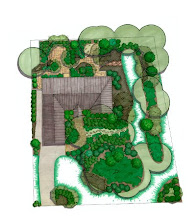Planting trees can enhance your landscape in many ways. Trees provide shade during the summer and wind protection during the winter. They add beauty and value to your property at the same time. They can also provide fun and adventure to children and privacy from nosy neighbor's prying eyes.
Trees are important to our environment and important to us as a species. They provide oxygen for us to breathe and filter all the bad carbon dioxide out of our air. They serve as the only source of nutrition to many animals and other organisms.
Because trees play such a visible and important role in our landscapes, care must be taken to ensure proper growth conditions are maintained. Trees are far more difficult,and expensive, to replace, once mature in the landscape, than other plants. However, with some proper instruction and planning, trees can be easily maintained.
The first step in choosing a tree is to determine the type of tree appropriate for your property and your needs. Make sure that whatever tree you choose can flourish in the local climate and soil conditions. Be sure to consult with the hardiness zones.
What To Consider When Planting Trees:
- Size of Space: How big will the tree be in 20 years?
- Proximity to concrete and asphalt structures, foundations, and drainage structures: How far is the site from any buildings, sewers, sidewalks, or streets? Trees spread out above and below ground.
- Climate Control: Deciduous trees planted on the south, east or west perimeters of the property provide shade during summer and allow sunlight through in winter. Evergreen trees planted on the north and west perimeters of property serve as windbreakers and can help to cut heating costs in winter.
-Drainage: Consider the natural drainage of the land. Plant young trees in good quality, well-drained soil. Stagnant water pooling around roots lead to "root rot" which is caused by lack of available oxygen. You can test the drainage of your soil by digging a hole and filling it with water. If the water hasn't drained in a few hours, it is likely you have a drainage problem in that area and it is not a good idea to plant there unless you create raised beds with about 12"-18" of good quality top soil to plant in.
- Soil Quality: What is the quality of the soil? Has there been any chemical or petroleum spills? Is there nay new construction nearby? Construction material and rubble, along with chemical or petroleum in soils, alter soil fertility. If the soil is determined unsuitable for planting, it is a good idea to scrape all the bad soil away and replace with good quality top soil at a depth appropriate for the planting materials.
- Personal Taste: Trees enhance the attractiveness of your property. Determine what trees you admire and what types you prefer in your yard. What will fill-in the space over time? You can consult a landscape designer during this process if you are unsure of what is appropriate. Vision Landscaping has full time landscape architects on staff to help you with any of these issues.
Types of Trees
Trees purchased from local nurseries and retail stores come in three types:
- Balled and Burlapped: The roots of the tree and the ball of soil containing the roots are bound in burlap.
- Container-Grown: The plant is sold in the container in which it was grown.
- Bare-Rooted: The plant is sold with the roots exposed. Not very common with trees.
When to Plant in Georgia:
Because we do not experience harsh winters, planting can occur during the winter while trees are dormant. Weather conditions are cool and allow plants to establish roots in the new location before spring rains and summer heat stimulate new top growth.
Watering:
Water newly planted trees at time of planting. Also, during the first growing season, water at least once a week during the absence of rain. However, care should be taken not to over-water becuase this could result in oxygen deprivation.
To see if you are watering your tree adequately, dig down 6"-8" at the edge of the planting hole. If the soil at that depth crumble in your hand, the tree needs water. Adequately moistened soil should form a ball when squeezed.
Mulching:
Mulch can be applied to the area around a newly planted tree to conserve moisture and promote water and air penetration. Do not, under any circumstances, cover the area surrounding the tree with plastic sheeting since air and water movement are prevented. Porous landscape material can be used.
Fertilizer:
All soils have their own history, so it can be beneficial to have the soil analyzed beforehand. Plants suffer root loss and stress associated with movement between ideal nursery grown conditions and the final planting, so adding fertilizer to the soil at the time of planting can compensate for root loss during planting and can alleviate transplant shock.
Now, remember that is takes at least a year for trees to adjust to their new living conditions. During this time, make sure they are being watered adequately and fertilize if necessary.
Friday, December 11, 2009
Thursday, December 3, 2009
Holiday Yard Cleanup
As the Holidays are quickly approaching, residents are less concerned with the overall look of their yards and more concerned with shopping, decorating for Christmas and planning parties and gatherings to celebrate the Holidays. Letting your yards go during the Holidays may seem like the easier thing to do, but did you know that Brown Recluse spiders live in piles of leaves and brush located around your house? Not to mention that mice and moles love these areas as well. Also, leaves piled up on top of your grass blocks out sunlight, potentially killing the grass underneath. It is equally important to clean your gutters. Over time, organic matter builds up along the gutter walls & after so long, things will begin to grow. Small trees and ferns will even take root if enough matter has gotten clogged in the gutters. If not kept clean, gutters will break and leak very easily. Vision Landscaping is the company to call to help oyu get your yard looking good this Holiday season. While your busy shopping and wrapping, we'll get busy mowing your grass, removing your leaves, cleaning gutters, pruning trees and bushes and removing weeds from lawn, beds and other areas. Call us today to schedule your Holiday Yard Cleanup!!
Friday, October 30, 2009
Drainage Issues Caused by Recent Heavy rains in Georgia
Drainage issues are very common in clay soil areas such as northeast Georgia and due to recent heavy rains and localized flooding, these issues are on the rise. These days, more and more people are dealing with drainage problems in their landscapes and making it a priority to contact a drainage consultant in order to deal with the issues properly. Vision Landscaping has had a record number of calls concerning drainage problems in the past two months.
The first step to correcting a drainage problem is to find where the water is coming from. The best time to do this is directly after a major downpour. Once the storm has cleared and it is safe to go outside, locate your gutters and downspouts. Determine how much water is flowing and where it is going. Most often, gutters and downspouts are installed on the home where it is most convenient, not where it is best for good site drainage. Is the water flowing away from the house, back toward the house or under a crawl space? Is the water from the downspout forming a stream that is running through your landscape or forming large puddles that are settling in your landscape?
Another common cause of poor site drainage is improper site grading before construction or landscape installation. Land must be graded so that water runs down hill away from the home or site where is puddles. Determine which way the slope of your property is going. You can purchase an inexpensive level at your local hardware store.
Another main cause pf poor drainage is the type of soil. Some soils, particularly clay soils, drain more slowly than other soils. With heavy rains and drainage issues, comes soil erosion problems. One way to test your soil to see if you have drainage issues is to dig a hole about 8 to 12 inches deep, fill full of water and let it drain completely. Wait a day and fill it again. Record the time it takes to drain completely out. If it drains within one hour, you have great drainage. If it takes a few hours, you have adequate drainage. If it takes more than ten to twelve hours or even overnight, you have a drainage problem.
Whatever the level of concern, Vision Landscaping can diagnose, offer advice and repair any drainage issue, problem or concern you may be having in your landscape.
Visit our website at www.vision-landscaping.com.
Written by: Mandy Reese, Vision Landscaping
The first step to correcting a drainage problem is to find where the water is coming from. The best time to do this is directly after a major downpour. Once the storm has cleared and it is safe to go outside, locate your gutters and downspouts. Determine how much water is flowing and where it is going. Most often, gutters and downspouts are installed on the home where it is most convenient, not where it is best for good site drainage. Is the water flowing away from the house, back toward the house or under a crawl space? Is the water from the downspout forming a stream that is running through your landscape or forming large puddles that are settling in your landscape?
Another common cause of poor site drainage is improper site grading before construction or landscape installation. Land must be graded so that water runs down hill away from the home or site where is puddles. Determine which way the slope of your property is going. You can purchase an inexpensive level at your local hardware store.
Another main cause pf poor drainage is the type of soil. Some soils, particularly clay soils, drain more slowly than other soils. With heavy rains and drainage issues, comes soil erosion problems. One way to test your soil to see if you have drainage issues is to dig a hole about 8 to 12 inches deep, fill full of water and let it drain completely. Wait a day and fill it again. Record the time it takes to drain completely out. If it drains within one hour, you have great drainage. If it takes a few hours, you have adequate drainage. If it takes more than ten to twelve hours or even overnight, you have a drainage problem.
Whatever the level of concern, Vision Landscaping can diagnose, offer advice and repair any drainage issue, problem or concern you may be having in your landscape.
Visit our website at www.vision-landscaping.com.
Written by: Mandy Reese, Vision Landscaping
Subscribe to:
Posts (Atom)

